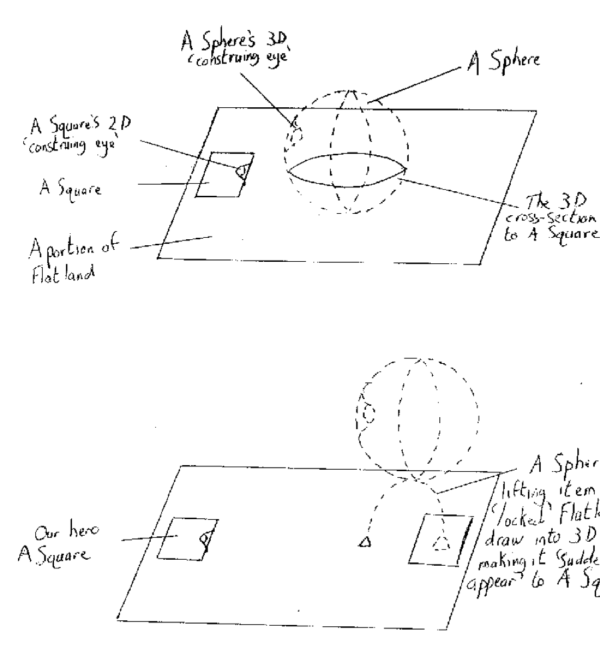 Want to know what I love most about these round-up posts? I love how my “must read” list expands into genres and styles of writing that I wouldn’t otherwise have discovered on my own. One of the ways I’ve been coping with the current political climate is to read as much as possible, and as widely as possible. I believe that by immersing ourselves in different perspectives (which books can do so well), we are inspired to grow, practice awareness, and find compassion for others. I hope you, dear reader, will also find new perspectives in whatever you’re reading, and that your “must read” pile of books is ever-growing.
Want to know what I love most about these round-up posts? I love how my “must read” list expands into genres and styles of writing that I wouldn’t otherwise have discovered on my own. One of the ways I’ve been coping with the current political climate is to read as much as possible, and as widely as possible. I believe that by immersing ourselves in different perspectives (which books can do so well), we are inspired to grow, practice awareness, and find compassion for others. I hope you, dear reader, will also find new perspectives in whatever you’re reading, and that your “must read” pile of books is ever-growing.
 We Are the Ants by Shaun David Hutchinson (Simon + Schuster, January 2016)
We Are the Ants by Shaun David Hutchinson (Simon + Schuster, January 2016)
Reviewed by Cassidy
The world is ending, and only one person can stop it. Sixteen-year-old Henry Denton is abducted by aliens and given two choices: press a big red button and save the world, or do nothing and watch everyone die in one hundred and forty-four days. It should be an easy decision. But after Henry’s boyfriend commits suicide and leaves behind no note or explanation, Henry isn’t sure the planet deserves to be saved. An in-depth exploration of grief and how we choose to survive, We Are the Ants is a brilliant, unique, compelling book that I never knew I needed. The book lives in a nebulous space between contemporary and science-fiction. Though Henry is very sure the aliens (or sluggers, as he calls them) are real, the reader is left questioning if they’re actually there, or a manifestation of a deeper trauma.
 Here by Richard McGuire (Pantheon Graphic Novels, 2014)
Here by Richard McGuire (Pantheon Graphic Novels, 2014)
Reviewed by Taylor
Richard McGuire’s graphic novel Here takes place in the same location at different times, going back and forth over billions of years. Through stunning full-page spreads and overlapping frames marked by the year, the reader simultaneously sees the living room of a 20th century house spanning generations in one family, the hunting grounds for Native Americans in the 1600s, the first colonial settlers, the glaciers of the past, the floods of the future, and everything in between. More than being a story with a defined plot, Here is a beautiful piece of art meant to highlight our undeniable impermanence in this world.
 Azumanga Daioh by Kiyohiko Azuma (Yen Press 2010)
Azumanga Daioh by Kiyohiko Azuma (Yen Press 2010)
Reviewed by Aaron
I’m currently reading two too-long books, so while I struggle with those, I’ve been cramming in lots of quick reads. The best of them has been Kiyohiko Azuma’s Azumanga Daioh, a long-running comic strip about girls in high school. Each four-panel strip is a strange delight, weaving through school activities, drunken teachers, bizarre dream sequences, and quiet moments of delight in cats. The characters are multitudinous and varied, so it never feels like the book is showing a “right way” to be a high school girl. The best moments of the strip come from the characters’ failures, especially when shown against the persistence of life and friendship despite those failures.
Well, no, the best parts are the trippy dream sequences with talking ponytails and mutant cat dads. But the friendship stuff is good too.
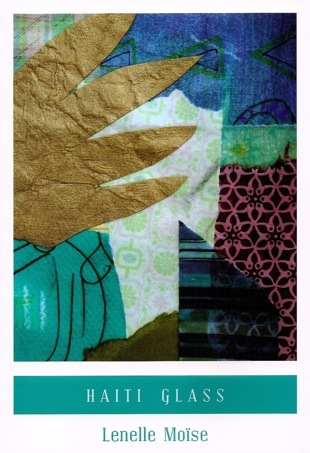 Haiti Glass by Lenelle Moïse (City Lights 2015)
Haiti Glass by Lenelle Moïse (City Lights 2015)
Reviewed by Wren
Do you ever have a poem stop you in your tracks? That’s how I first encountered Lenelle Moïse’s work. I get the “Poem of the Day” emailed to me from Poetry Foundation, and when her poem “quaking conversation” showed up in my inbox, it shook me to my core. I immediately ordered Haiti Glass from City Lights and devoured it in a single sitting. The collection is a complex, raw love letter to Haiti and the people that live there. It’s at once heartbreaking and joyful, fierce and tender. Moïse deftly wields language to expose and surrender to the complexities of this living, breathing portrait of Haiti. And so, I’ll leave you with the last stanza of “quaking conversation”, the poem that first sparked something in me as a reader:
come sit, come stand, come
cry with me. talk.
there’s much to say.
walk. much more to do.
Happy reading, and listening, and doing, folks.
What We’re Reading: Jerusalem, Part 1

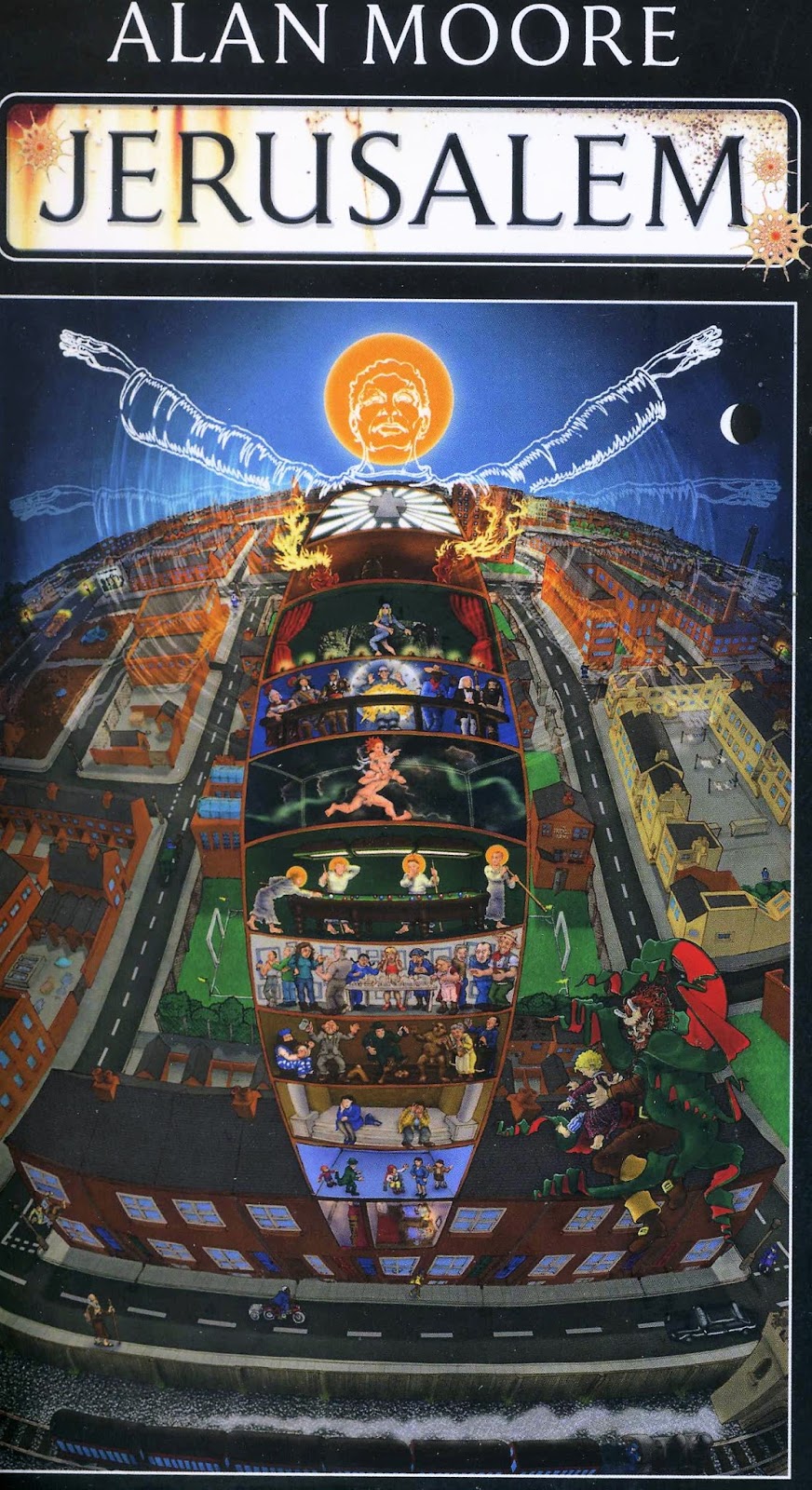 One of Hazel & Wren’s New Year resolutions is to find new ways to engage with and review books. You’ve already seen our review roundups, and here’s another grand experiment: a yearlong, co-reviewed readalong of Alan Moore’s newest novel, Jerusalem.
One of Hazel & Wren’s New Year resolutions is to find new ways to engage with and review books. You’ve already seen our review roundups, and here’s another grand experiment: a yearlong, co-reviewed readalong of Alan Moore’s newest novel, Jerusalem.
Jerusalem is 1,200 pages of magical realism, historical fiction, and experimental prose about Northampton, England. Each month, we’ll read approximately 100 pages and post a short roundtable discussion. And the coolest part? You can read along and join the discussion! Let’s pick this beast of a book apart.
This month, Josh and Aaron will be discussing the first 97 pages. With 1,100 pages to go, there’s still time for you to grab a copy and join in.
Aaron: A majority of the first 100 pages is about members of the Vernall family across generations. One restores church frescoes in the late 19th century. Others paint and dream in the modern day. All of them suffer from mental illness.
First of all, it feels like this is going to be a book about perspective. Alma’s opening scene is about architecture and angles, and she thinks about the family madness in metaphor, pondering those ancestors who’ve gone round the turn, the bend, the twist, effectively disappearing from view. Mental illness makes someone invisible, no longer able to be perceived in traditional ways.
Josh: It’s a curious way to start a book, right? It at once lets us know the scope of this thing he’s given us, the truly omniscient attempts at narration. It’s as though Moore wants to be clear with us right from the get-go: this book will shy away from no consideration of place, person, or perspective, so buckle up. It reminds me of Mervyn Peake’s Gormenghast books wherein Peake is happy—thrilled, even—to spend huge amounts of time widening his perspectival scope, not for considerations of plot or even character but because of his fidelity to truth, as though you can only really understand a person in a place by totally and completely seeing/understanding the place itself. This seems to be a touch of what Moore is after here right from the start.
A: The Gormenghast reference is a perfect one! I loved how inseparable Peake’s prose was—labyrinthine, precarious, and unexpected—from the shape of Gormenghast Castle. It forced the reader to experience from the perspective of the characters.
And speaking of characters’ perspectives, when Ginger Vernall is raised up to paint a chapel ceiling, he has the pleasure of looking down on two monks coming around a corner at the same time. Ginger knows beforehand that they’re going to collide before it happens; in the right conditions, perspective can be the same thing as precognition.
Are the strange visions the characters suffer also a consequence of a changed perspective? And does that perspective shift come from their mental illness, or does the madness come from a changed perspective? Or it something more magical, more science-fictional? Are there actual angels and demons who are viewing us from a higher dimension and thus appear to teleport or extrude themselves into our world in weird ways a la Flatland?
(diagram from Flatland)
J: I’ve been wondering some of this same stuff, too! The supernatural, such as it is, walks a really thin line here, I think. The elision of madness and magic is well-trod territory and can verge on offensive when romanticized, but Moore seems really interested in showing both sides of that line: the beauty and wonder of seeing angels building in the middle of the night juxtaposed with lives and bodies and minds broken, seemingly irreparably.
I’m curious to read more and see how the book continues to make use of the supernatural forces here that seem to be flittering around the edges of things, coming forward at moments and hanging back at others.
A: Taking a turn from the supernatural to the realistic: Jerusalem also feels like a book about the working class. Moore’s Northampton is poor and dirty, full of damaged infrastructure , subsidized housing, and CCTV cameras. Food is scarce in Ginger’s time, and pubs are empty in the present day. No one has money to spend, but they work all the time. With so many novels about writers, professors, and other white-collar workers, it’s nice to read something about the blue collars.
J: Yes! I was thinking this same thing. I’m fascinated by the way Moore navigates space in this book; it feels very Dickensian to me. Class (and specifically the working class) seems to somehow thrive in these tight, sometimes-grubby, carefully described, much loved spaces, especially since most of the spaces in this book become defined by their workability. Even the sense of beauty Moore finds in this place is often wrapped up in industrialization of some sort.
“A fat pearl cylinder of failing daylight coloured by the worsening storm outside dropped from the windows of the Whispering Gallery to the cathedral’s flooring down below, dust lifted by the bustling industry caught up as suspension in its filmy shaft” (50).
A: And being stuck in the working class, being stuck in a dead-end job or with a drug addiction like Marla has in the third section of the book—that’s its own form of perspective limitation. Marla herself hints at it when she’s thinking about her drug addiction:
“Not feeling like a fucking angel on fire, forget that, that’s not going to happen for you anymore, no, no, just feeling like a fucking person like you was again for just ten fucking minutes, that’s your fucking big ambition these days. Heaven, where you went the first time, that’s all shut. The ordinary world you used to be in, that’s shut too, most of the time, and you’re stuck somewhere else, somewhere that’s under all of that, like being under fucking ground.”
Marla, as a person of color, a sex worker, and a drug addict, has had her perspective squashed like a Flatlander’s. She can’t see up or down, only looking forward.
J: Your ideas about perspective limitation are really great, and Marla is a great example of this. She has such a complicated relationship with memory—she seems to be a character at once struggling to keep one foot out of the past and the other in her present. I keep thinking of her interaction with that fellow on the street—the one with the big nose who Marla tries to take a run at. I wonder about how that interaction gets narrated, with Marla continuously running into her inability to figure this guy out, getting caught up on his strange speech, unable somehow to extend her perspective deeper into who he might be or what might be going on with him (beyond just calling him “really mental”).
I’m wondering about the place of the reader in this book. At times during these first 100 or so pages, I felt encouraged—even demanded—to pay really close attention to detail in the text. Moore pushes off plot in favor of this encyclopedic lens—every detail, significance thrown out the window, recorded and captured. And so I invest myself where he asks me to, but there are times where I feel a little punished for that investment. I end up overloaded, juggling information (like reading one of the great Russian novels and trying to keep characters straight in your head) that I have no idea how to prioritize. Did you experience anything like that?
A: Not consciously, but now that you brought it up, jeez! So many thoughts.
When I started the book, when I was walking through that first dream world, I definitely considered keeping a list of characters and relationships and terms I didn’t understand—with everything being given that same encyclopedic (great term for it, by the way) weight, I was left without the traditional narrative signals of, “Hey, this thing is important!”
Feeling that way, though, always pulls me in two directions. The first is, “Everything is important and I must keep track of it all.” That was the note-taking instinct…which I ignored, because I’m a terrible student. Instead, I ended up where I always end up—with everything being given the same narrative weight, I felt like it was up to me to choose what was important to me. With everyone in the book walking everywhere (which is probably something I’ll come back to), I get the pleasure of walking along with them, focusing on things that catch my eye and letting my eyes glaze over if they need to. But maybe I’m just a bad reader. Regardless, it reminded me (probably on purpose) of Mrs Dalloway and Ulysses and all the other British walking-around novels.
Next month, we’re reading to page 207. Please join us!
Supplemental reading:
Flatland: A Romance of Many Dimensions (1884) by Edwin Abbott Abbott
Titus Groan (1946), Gormenghast (1950), and Titus Alone (1959) by Mervyn Peake
Mrs Dalloway (1925) by Virginia Woolf

This week let’s focus on family dynamics, or at least a moment in a family’s day. Will the moment you choose be mundane or fraught with emotion? Quiet or chaotic? Here are three moments in three different families to get you started.
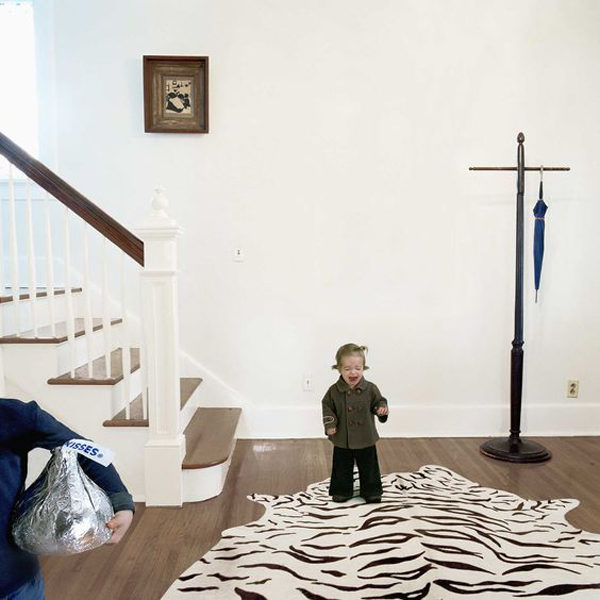
Julie Blackmon, Stolen Kiss, from Domestic Vacations series. Photograph. www.julieblackmon.com
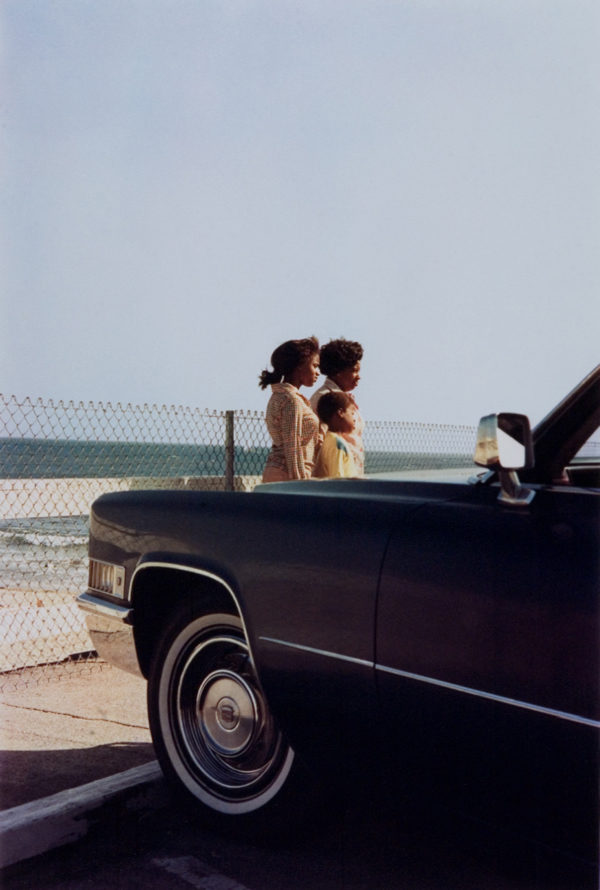
William Eggleston, Black family by the sea, published in Los Alamos, 2002. Photograph. www.egglestontrust.com

Larry Sultan, Close Up, 1992, from Pictures from Home series. Photograph. www.larrysultan.com
What We’re Reading: As I Descended
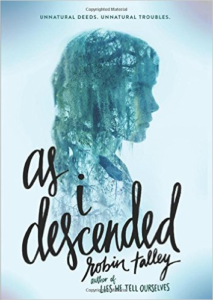 As I Descended by Robin Talley (Harper Teen, September 2016)
As I Descended by Robin Talley (Harper Teen, September 2016)
I have a longstanding theory that all literature, movies, and media can be improved by adding lesbians. Dante’s Inferno? Would be better with lesbians. Citizen Kane? Better with lesbians. Space Jam? Better with lesbians. Heck, I’d probably finally read David Foster Wallace if he added in some lesbians. As a self-identified Shakespeare nerd, you can only imagine my excitement when I discovered Robin Talley’s As I Descended, a retelling of Macbeth set in a boarding school where both M and Lady M are teenage girls.
The curtain opens on Maria Lyon and Lily Boiten, Acheron Academy’s resident power couple. It’s the girls’ senior year, and there’s only one thing standing in the way of their post-graduation happily ever after: the distinguished Kingsley Cawdor Scholarship. Whoever wins is guaranteed a free ride to any college in the country, and it’s the one thing Maria needs to lock in her Stanford acceptance. But the Kingsley Cawdor Scholarship is all but promised to golden child Delilah Dufrey. When Maria and Lily ask a Ouija board to take Delilah out of the picture, they get much more than they bargained for.
Retellings of classic tales are always finicky creatures. Stay too close to the original, and the writing can feel lazy, more plagiarism than homage. Stray too far, however, and the source material can become unrecognizable, at which point it seems useless and gimmicky to call it a retelling at all. As I Descended hits that sweet spot right in the middle. It’s a unique enough take to make it a fresh, exciting read, but contains enough references to Macbeth that the reader (if familiar with Shakespeare) feels like they’re being let in on an inside joke. The rival soccer team is called “Birnham.” All of the chapter headings are quotes from the play. After (spoiler alert) Delilah Dufrey mysteriously falls from a window, Lily even has a delicious “out, damn spot!” monologue.
The deviations from the original script (as is true with all good retellings) ended up being some of my favorite aspects of the book. There’s the genderbending of Macbeth to Maria, of course, which Talley turned into a study of female ambition that we don’t often see in young adult lit. Maria is also Latina in this version, and Talley beautifully weaves in Mexican folklore, turning the infamous three witches into the legendary and terrifying figure of La Llorona. The rest of the cast is diverse as well; Lily is disabled, MacDuff is Latino, and the MacDuffs are also a gay couple. There’s no reason for any of these “diverse elements” to exist, which makes it all the more perfect. Talley has simply updated an all-white, all-straight, predominantly-male cast to reflect what real communities actually look like.
The other main change is one that may divide readers, but which I absolutely loved. In the original Macbeth (depending on which English professor you listen to), there are supernatural forces at work, but the reader never knows exactly how much of a role they play. Is Macbeth really haunted by Banquo’s ghost, or is he just consumed by guilt? Is there really spectral blood on Lady Macbeth’s hands, or is she simply mad? Did the soldiers really disguise themselves as trees in the end and think that was a good war strategy, I mean, really, Shakespeare? Really?? Regardless, the ambiguity, some argue, allows for a more nuanced discussion of character and how far people will go to attain their heart’s desire. In As I Descended, Talley does away with this ambiguity altogether in favor of a spookier conclusion: there are ghosts at work at Acheron Academy, and the tragedy that results is almost entirely their fault. The ghosts push Delilah out of the window. The ghosts provide an unseen force which kills Brandon (our Lady MacDuff). The ghosts drive Lily to drown herself. I love a good horror novel, and to me supernatural thrillers are just as satisfying as psychological ones, so I had no qualms with Talley taking artistic license in this direction.
In conclusion, Talley worked this retelling masterfully. If she decided to rewrite the entire Shakespearean canon with contemporary (and queer) themes, I would devour each and every book. (Hint, hint, Robin Talley, if you’re reading this.)
Have you read any good retellings lately?
